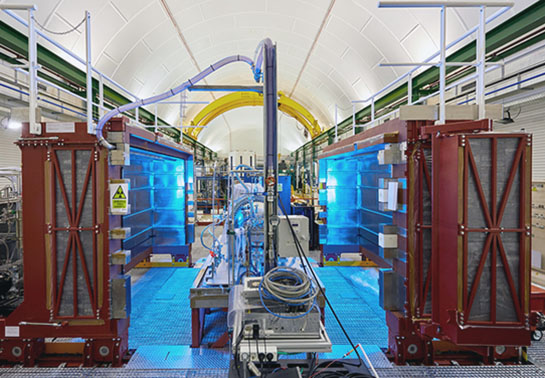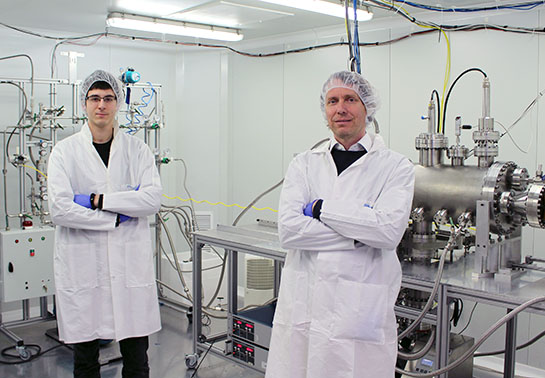IFIC takes a major step towards the measurement of the strangest physical phenomenon in the Universe
- Fundació Parc Científic
- February 21st, 2019

NEXT experiment begins to work with enriched xenon, with which the scientists expect to prove that neutrino is its own antiparticle. This result would answer one of the most important unanswered questions of Physics and Cosmology: why is our universe composed of matter instead of antimatter when at its beginning identical quantities of particles of all types were created. Apart from leading the international collaboration of the experiment, IFIC has also developed a sophisticated control system that is expected to detect the phenomenon.
At the beginning of February, the NEXT experiment, a scientific international collaboration lead by the Institute for Corpuscular Physics (IFIC, CSIC-Universitat de València), at the Science Park of the academic institution, started operating with Xenon-136, a variety of the noble gas with which the research tem expects to be able to ‘catch’ the strangest phenomenon ever observed in the Universe: neutrinoless double beta decay.
If the experiment turns out to be a success, they would prove the neutrino, one of the most abundant elementary particles, is its own antiparticle, a fact that would solve the mystery of how the Universe was created with the matter we are able to see. In 2019, the second stage of the experiment, NEXT-White, will work at the Canfranc Underground Laboratory with 5 kilos of enriched xenon thanks to a sophisticated control system developed by the IFIC.
NEXT consists of a time projection chamber (TPC) full of high pressure xenon gas. This particle detector allows to register the neutrinoless double beta decay mark, a process that is so exceptional that it is estimated that it would take longer than the age of the Universe to be produced. In order to achieve that, NEXT uses a type of xenon (136Xe) in the nucleuses of which there is a large number of neutrons, the third known element with the longest average life. By concentrating a high volume of high pressure xenon, it is expected to trigger a decay of these neutrons in a process the result of which would be the emission of two electrons of similar characteristics without producing neutrinos, which would be the proof that a neutrino it’s its own antiparticle.
Apart from the configuration of the detector, it is required that the enriched xenon, an extremely expensive and volatile gas, is contained in the inside at the desired pressure (between 10 and 15 bars) in unprecedented purity and tightness conditions for a particle physics experiment. For that purpose, the team of the Institute for Corpuscular Physics that lead NEXT has developed a control system that allows gas leaks inferior to 10 gr per year, with several computerized recovery systems and with the purity conditions required to not contaminate xenon, obtaining only 0.1 parts per billion of oxygen in the system.
‘It hasn’t been easy, because the system through which the gas flows has an important volume in comparison to the detector, and more than 300 connections from where it can escape’ claims Marc Querol, NEXT engineer with a technical contract of the Ministry of Science at IFIC. Querol designed and programmed the gas control system, as well as the method to control its vacuum and guarantee the purity of the xenon. Heat is used to ‘clean’ the system components and through mass spectrometry they check the abundance of other elements like oxygen. ‘If we have too much oxygen inside the detector we won’t be able to see the signal induced by the two electrons that are created at the end of the double beta decay’, explains Michel Sorel, principal scientific of CSIC and in charge of NEXT at the IFIC.
Until now, NEXT-DEMO, the first experiment prototype developed entirely at IFIC, as well as NEXT-White, the second stage installed at the Canfranc Underground Laboratory since 2016, have worked with natural xenon and depleted xenon, which have a limited concentration of the 136 isotope. Now that the purity and tightness conditions required for the experiment have been achieved, as well as other important advances in the taking of measures in the detector, the laboratory has given the approval to operate with enriched xenon, an operation that began last February 7th and which will be developed until the end of 2019. This will be the last stage of the NEXT-White, which works with 5 kilos of enriched xenon and it’s useful to prove the validity of the experiment before NEXT 100, 100 kilos of xenon that will be operational in Canfranc in 2020.
In the last stage of NEXT-White, the scientists expect to detect another strange decay, the two-neutrino double-beta decay, the mark of which is almost identical to the one the neutrinoless double beta decay has, although its average life is a bit shorter. According to Sorel, only two experiments, KamLAND-Zen (Japan) and EXO-200 (USA), have been able to detect neutrino double-beta decay, but in recent data (2011) and using a higher volume of xenon. According to Sorel, ‘it would be possible that NEXT could measure that with only 5 kilos, because it accumulates less background noise than other experiments thanks to the configuration of the detector, which allows to identify a clean signal’. Other configurations that allow to improve the identification of the signal are being studied for NEXT-100.
For the IFIC researcher, going from 5 to 100 kilos of enriched xenon in one year won’t be too complicated because ‘the key elements like the vessel of the detector, the coating to armour the experiment and the actual gas control system are already prepared for NEXT-100.’ Thus, they expect that in a period of 5 years NEXT will prove its own ability to detect neutrinoless double beta decay so that they can extend it to tonne scale.
NEXT is a scientific collaboration lead by the Institute for Corpuscular Physics in which other Spanish teams participate: University of Santiago de Compostela, Autonomous University of Madrid, University of Zaragoza, University of Girona and the Universitat Politècnica of Valencia), as well as other teams from the United States, Portugal, Russia, Colombia and Israel. The representatives are Juan José Gómez Cadenas, from the Donostia International Physics Center (DIPC) and David Nygren, from the University of Texas at Arlington.

More information:
File in: Astronomía y Astrofísica , Física
















